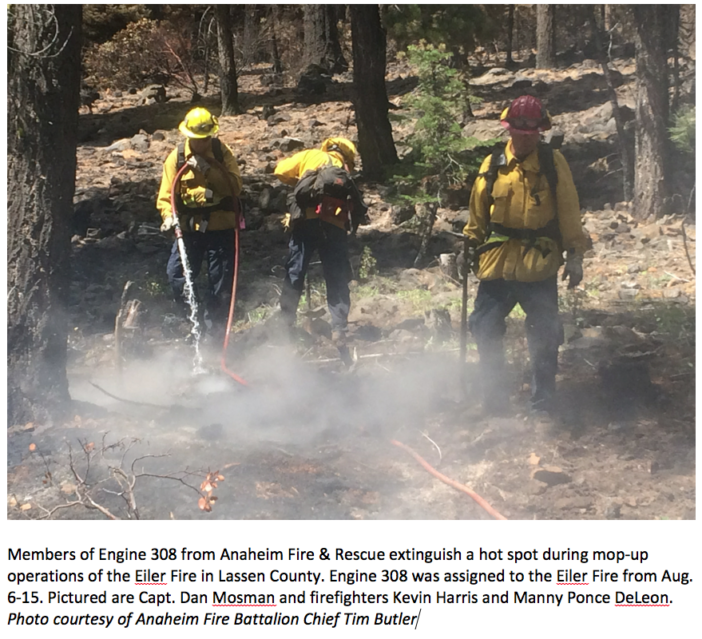For several days in searing August heat, he charged up a rugged singletrack trail, climbing 1,600 feet in four miles over rocks and “snags” (parts of burnt trees) while carrying 40 pounds of firefighting equipment.
It wasn’t part of any official diet regimen, but Patrick Russell, over the course of nearly two weeks in temperatures approaching 100 degrees, melted away seven pounds on his imposing 6-foot-9-inch frame – an Anaheim firefighter doing some good far away from home.
About six to 10 times a year, Anaheim Fire & Rescue dispatches strike teams and incident managers to areas throughout the state when local agencies are overwhelmed by major fires or other large-scale incidents such as earthquakes or civil unrest.
From Aug. 1 through Aug. 15, Russell was away from his usual perch behind a desk at AFR, where as Deputy Chief of Operations he oversees 10 engine companies, six truck companies and two paramedic squads – resources that roll out to about 30,000 emergency incidents a year in Anaheim alone (85 percent of these calls are for medical aid).
Russell, 49, wasn’t the only Anaheim firefighter who recently helped stamp out infernos raging far away from Anaheim. Roughly during that same time period, about 30 AFR firefighters fanned out to fires that were ignited by lightning in five different wilderness areas in NoCal.
The show of force was triggered by AFR’s status as a participating agency in the California Fire Assistance Agreement, whose members are reimbursed by the Office of Emergency Services in Sacramento for helping out on longer-term incidents such as major wildfires.
In addition, AFR is one of about 830 fire departments that voluntarily participate in the state’s Master Mutual Aid Agreement, in which aid is rendered for up to 12 hours to agencies whose resources are overwhelmed.
“It’s kind of neighbor helping neighbor,” Russell said of participants in the Master Mutual Aid pact.
Russell was the only AFR employee sent to the Coffee Creek Fire, a blaze that ignited July 30 and that as of Friday, Aug. 22 had chewed up 6,258 acres in the Shasta-Trinity National Forest, northeast of Redding.
“This is shaping up to be a busy year,” Russell said of wildfire activity statewide as California remains in the chokehold of a serious drought – with the official “fire season” not even here yet.
Russell, a veteran firefighter of almost 30 years who has been with AFR for 24 years, was part of the incident management team assigned to the Coffee Creek Fire.
“We were in a tough spot,” Russell said of the steep and remote terrain that ranged from an elevation of about 4,600 feet to 6,200 feet. “But I like the challenge of going to different areas and helping out other firefighting agencies.”
The area roamed by firefighting crews assigned to the Coffee Creek Fire was so steep and rugged that helicopters could not land with supplies.
Instead, a small army of about 30 U.S. Forest Service-owned pack mules — Jedd, Roxy and Joe were among their names — was used to haul up hoses, pumps, water, food, and other supplies.
The larger mules carried up to 300 pounds while the smaller ones humped up 150 pounds worth of supplies and equipment, Russell said.
Also from early to mid-August, AFR strike teams rolled out to the Way Fire in the Sequoia National Forest, the Beaver Fire in the Klamath National Forest, the Bald Fire in the Lassen National Forest and the Eiler Fire, also in the Lassen National Forest.
When responding to major wildfires and other incidents outside of Anaheim and Orange County, authorities at AFR and other agencies first ensure that enough resources remain to adequately respond to any critical incidents in the local region, Russell said.
“It’s kind of like a chess game,” Russell said of assessing and moving around resources. “It’s a balancing act of what we can send out and what we need to keep.”
Russell says he’s glad to be back in Anaheim but waits for the next call for him to be sent outside of Anaheim.
“The relationships built between our firefighters and those throughout the state only help us should we ever need assistance from beyond our city boundaries,” he says.
A couple of days later, his phone does ring — and Russell’s off to fight another faraway fire.
 Behind the Badge
Behind the Badge




